O lago Otjikoto e as suas diferentes narrativas
DOI:
https://doi.org/10.51359/2526-3781.2023.258107Keywords:
Otjikoto Lake, colonialism, Hai//omAbstract
In January 2023, within the scope of the activities of the project “Intercultural Education as a Dialogue between Ways of Knowing and Forms of Knowledge: Multistrategic and Collaborative Research in Traditional Communities” (funded by the Brazilian National Council for Scientific and Technological Development/CNPq, Grant n. 423948/2018-0), we carried out a field trip to Namibia. The intent was to collaborate in a study conducted by researchers from the University of Namibia, under the coordination of Cynthy Haihambo, about the school dropout of students from different San peoples – Hai//om, Ju/hoansi and !Kung – and the prospects for transforming the education provided to these peoples in order to decrease dropout rates. In one of the field trips during this stay, two colleagues from the University of Namibia – Cynthy Haihambo and Misitilde Jonas-Iita – and a Hai//om contact person – Martha Xoagus, who was mediating the contacts with local communities and leaders in the settlement of Tsintsabis and surroundings – took us to visit the Lake Otjikoto National Heritage Site, located near the city of Tsumeb, in the Oshikoto region, about 450 kilometers from the country’s capital, Windhoek. This sinkhole lake is one of the only two permanent natural lakes found in the country (the other is lake Guinas, only 32 Km from Lake Otjikoto).
When we arrived at Lake Otjikoto, we were accompanied by a local guide who introduced us to the “history” of the place, describing how the lake was formed when a cave roof collapsed. This allowed the outcrop of an underlying water reserve, which occupies part of a complex of underground caves. The fact that the lake tapers into a system of lateral caves makes it impossible to determine its exact depth, but it is estimated that it varies from about sixty meters at its margins up to around 100 meters at its deepest parts.
The guide also described how the German colonial government used the lake’s water in the exploration of a copper mine in the nearby town of Tsumeb, as well as that today the water is used to irrigate plantations in the region, the most important agricultural area in the country. Furthermore, he tolds us that in 1915 the German colonial army, in order to avoid handing over their weapons to South African and British troops, threw them at the bottom of the lake, together with a safe that has not been found until today and whose contents are not known, what sparks the imagination of many treasure hunters.
According to the guide, Otjikoto lake “was discovered” by the European explorers Francis Galton (half-cousin of Darwin, involved with social Darwinism and eugenic thinking) and Carl Johan Andersson in 1851. When we listened to the guide’s explanation, we questioned if the local people did not know it. At that moment Martha, who is a Hai//om, interrupted him to tell us that in the past “a group of Hai//om people was walking around the place, where there was only a stone path. One group of men walked in front, another group of women followed. The front group said that the earth was shaking and, suddenly, the roof of the cave fell and the group of women drowned in the lake. That’s why the Hai//om named it 'ugly lake' (Gaisis).” The designation “Otjikoto” (“deep hole”) was given by the Herero, when they came to occupy the area. This lake is still considered cursed or haunted by the Hai//om, Martha remarked.
This photo essay aims to describe the invisibilization of the Hai//om history and of their relations with Lake Gaisis or Otjikoto. There is no mention of the history of these people about the origin of the lake, which contrasts with the presence of a plaque celebrating the arrival of the European explorers. Likewise, no mention is made of the presence of a Hai//om cemetery near the lake, which contrasts with the presence of a plaque remembering the death of a South African tourist when diving in the lake. The only presence of the Hai//om is limited to an exoticized and sensualized representation of them on a mural that welcomes visitors at the entrance to the site, alongside the “exotic” animals of the local fauna. This invisibility clearly reproduces the colonial pattern of creating a history that aims to silence the local populations in the face of the arrival of European colonizers, a history that continues to this today to be fought in the struggle of the Hai//om, as well as of Indigenous peoples in Brazil and worldwide, for the recognition of their lands. The arguments in this paper are linked to the decolonization of views about historical events, as part of an effort to correct how they are misrepresented in African, such as Namibia, as well as in several other countries.

Published
Issue
Section
License
Copyright (c) 2023 AntHropológicas Visual

This work is licensed under a Creative Commons Attribution-NonCommercial 4.0 International License.
Direitos Autorais para trabalhos audiovisuais publicados na AntHropológicas Visual sã licenciados para uma licenca Creative Commons 4.0 BY-NC.
